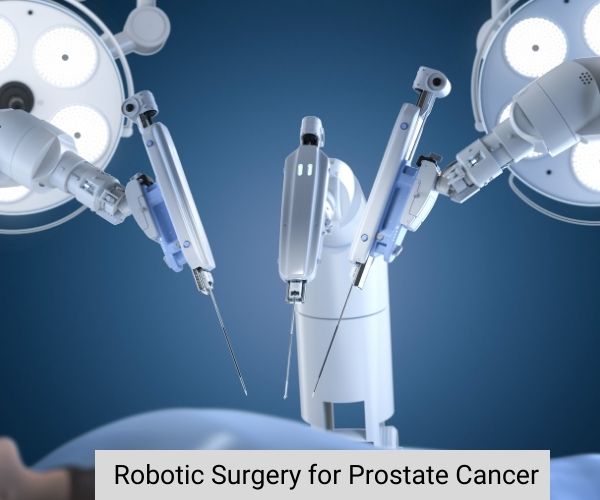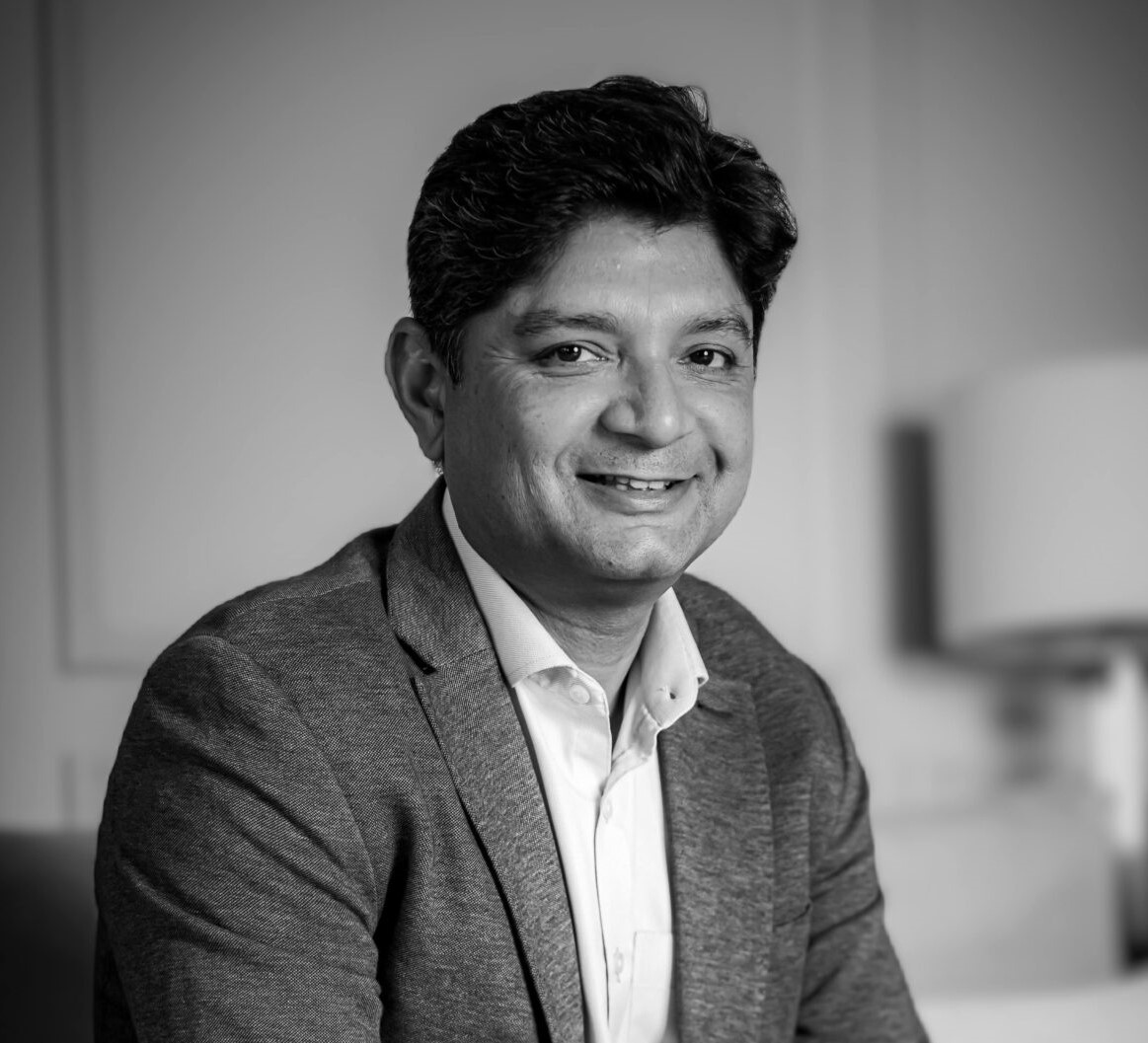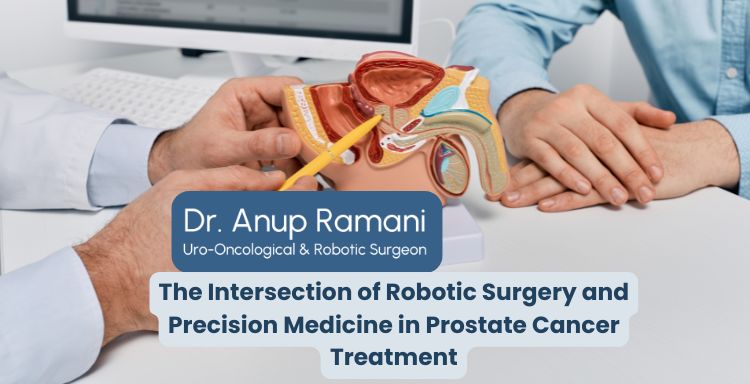Dr Anup Ramani @ Copyright 2024
By Dr. Anup Ramani
Prostate cancer remains one of the most common cancers among men globally. Advances in medical technology are revolutionizing how prostate cancer is treated and one of the most ground-breaking combinations is the intersection of robotic surgery and precision medicine. Robotic radical prostatectomy (RRP) has emerged as a game-changer in prostate cancer surgery, offering higher precision, less invasiveness and quicker recovery times. When paired with precision medicine, which tailors treatment to the genetic profile of the patient’s cancer, the results can be even more remarkable. In cities like Mumbai and across India, this combination is not only improving surgical outcomes but also providing more personalized care.
This article explores how robotic surgery and precision medicine work together to optimize prostate cancer treatment, focusing on how these advancements are reshaping the approach to prostate cancer care in India.
How Does Precision Medicine Enhance Prostate Cancer Treatment?
Precision medicine is an innovative approach that tailors medical treatment to the individual characteristics of each patient’s disease. In prostate cancer, precision medicine focuses on analyzing genetic mutations, biomarkers and other molecular features of the tumor to identify the most effective treatment options.
Precision medicine provides several benefits in prostate cancer treatment:
- Early Detection and Diagnosis: Precision medicine can detect prostate cancer at its earliest stages by identifying biomarkers or genetic mutations that are associated with the disease. This allows for earlier intervention and potentially better outcomes.
- Personalized Treatment Plans: One of the key benefits of precision medicine is that it enables doctors to design treatment plans that are specifically tailored to the patient. Based on the tumor’s molecular profile, treatments like surgery, radiation or hormone therapy can be customized to target specific cancer-driving mutations.
- Optimizing Treatment Response: Not all prostate cancers behave the same way. Some may be more aggressive, while others may grow slowly. Precision medicine allows doctors to predict how the cancer will respond to treatment, helping them make more informed decisions on which therapies to pursue.
- Minimizing Side Effects: By using precision medicine to understand the genetic makeup of the cancer, doctors can choose therapies that are less likely to cause side effects, improving the overall quality of life for patients.
The use of precision medicine alongside robotic surgery is revolutionizing prostate cancer care by offering highly personalized treatment options and improving the likelihood of successful outcomes.
How Robotic Surgery and Precision Medicine Work Together in Prostate Cancer Treatment?
The combination of robotic surgery and precision medicine represents a new frontier in prostate cancer treatment. While robotic surgery offers the technical capability to perform precise and Minimal invasive procedures, precision medicine provides a personalized roadmap for treatment. Together, these innovations ensure that patients receive the most effective care possible.
Here’s how they intersect:
- Surgical Precision Informed by Genetic Insights: Robotic surgery allows surgeons to remove the prostate with high precision, even in areas that are difficult to reach with traditional surgery. Precision medicine provides crucial information about the tumor’s genetic profile, helping the surgeon to make informed decisions about which tissues to remove and how to preserve important structures, such as nerves, to minimize side effects like erectile dysfunction and incontinence.
- Targeted Treatment Plans: Precision medicine allows oncologists to customize a treatment plan based on the specific characteristics of a patient’s prostate cancer. This means that, in addition to robotic surgery, patients may also receive complementary treatments such as chemotherapy, radiation or hormone therapy that are best suited to their cancer’s genetic makeup.
- Post-Surgical Monitoring: After surgery, precision medicine plays a key role in monitoring cancer recurrence. By analyzing genetic markers and molecular profiles, doctors can detect early signs of recurrence and adjust the treatment plan accordingly. Robotic surgery, combined with the precision provided by molecular testing, helps doctors offer proactive follow-up care tailored to the patient’s needs.
- Minimizing Side Effects: Robotic surgery reduces the trauma associated with traditional surgery and when combined with precision medicine, it helps reduce the risk of side effects such as incontinence and erectile dysfunction. Personalized treatment ensures that each patient’s care is optimized for the best possible quality of life after surgery.
The synergy between robotic surgery and precision medicine enables a holistic approach to prostate cancer treatment that not only removes the tumor but also considers long-term recovery, side effects and personalized care.

When Is Robotic Prostate Cancer Surgery Recommended?
Robotic prostate cancer surgery is typically recommended for patients who have localized prostate cancer, meaning the cancer is confined to the prostate gland and has not spread to other parts of the body. Candidates for robotic prostatectomy typically include:
- Early-Stage Prostate Cancer: Men diagnosed with early-stage prostate cancer (Stages I and II) often have the option of robotic surgery. The goal is to remove the cancerous prostate while preserving surrounding tissues.
- Good Overall Health: Robotic prostatectomy is often recommended for men in general health who are expected to recover quickly from surgery. Precision medicine can help identify patients who may benefit most from this approach based on their genetic profile.
However, not all prostate cancer patients are candidates for robotic surgery. Factors such as the size and location of the tumor, as well as the patient’s overall health, play a critical role in determining the best treatment option. Precision medicine helps oncologists make these important decisions by providing insights into the genetic and molecular aspects of the disease.
What Our Patients Are Saying
Dr. Anup Ramani: Best Robotic Prostate Cancer Surgeon in India
India has become a hub for advanced medical treatments, including robotic prostate cancer surgery. Dr. Anup Ramani, offers state-of-the-art facilities for robotic prostatectomy in Mumbai. This is equipped with the latest robotic systems, such as the da Vinci Surgical System, which enables to perform precise prostate cancer surgeries.
Mumbai, is home to some of the country’s leading prostate cancer specialists and urologists who are pioneers in robotic prostate cancer surgery. Dr. Anup Ramani offer comprehensive treatment plans that may incorporate both robotic surgery and precision medicine to ensure the best outcomes for patients.
Conclusion
The intersection of robotic surgery and precision medicine is fundamentally transforming the treatment of prostate cancer. Robotic radical prostatectomy offers unparalleled precision and Minimal invasive surgery, while precision medicine provides a personalized approach to treatment, ensuring that care is tailored to the unique genetic profile of each patient’s cancer. Together, these two approaches are providing better outcomes, faster recovery and improved quality of life for prostate cancer patients.
In cities like Mumbai and across India, these advancements are making prostate cancer treatment more effective and accessible, offering hope to men diagnosed with the disease. As medical technology continues to evolve, the integration of robotic surgery and precision medicine will remain at the forefront of prostate cancer care, paving the way for even more effective treatments in the future.
FAQs
What is robotic prostate cancer surgery?
Robotic prostate cancer surgery uses advanced robotic technology to remove the prostate gland with minimal incisions, offering greater precision, reduced recovery time and fewer complications than traditional open surgery.
How does precision medicine help in prostate cancer treatment?
Precision medicine uses genetic and molecular profiling to customize treatment plans based on the unique characteristics of a patient’s cancer, ensuring more effective and targeted therapies.
Is robotic prostate cancer surgery safe?
Yes, robotic surgery is generally safe and has been shown to reduce blood loss, scarring and recovery time compared to traditional surgery. It is widely used for patients with localized prostate cancer.
What is the recovery time after robotic prostate surgery?
Most patients can return to normal activities within 1-2 weeks, with full recovery expected in about 4-6 weeks, depending on individual health conditions.
About Author

Uro-Oncological & Robotic Surgeon
Dr. Anup Ramani is a robotic uro-oncological surgeon and an internationally recognized expert in robotic surgery for prostate, kidney and urinary bladder cancers. With more than two decades of robotic experience and 2,000+ robotic procedures, he brings unmatched precision and outcomes to complex uro-oncology cases. He is widely published in his field and is known for a personal, transparent approach-often spending over an hour in initial consultations to educate patients on its disease, surgery and recovery. His expertise spans prostate cancer treatment, kidney and bladder cancer surgery, adrenal gland surgery, kidney stone treatment, penile cancer surgery and enlarged prostate management. Dr. Ramani advocates the advantages of robotic surgery-magnified 3D vision, tremor-filtered precision, minimal scarring, lower blood loss and faster recovery-helping patients return to life sooner.
Table of Contents
Recent Blogs
Best Uro-Oncological surgeon
Specialist in India for Robotic Surgery
MCh, DNB, MS, DNB
Dr. Anup Ramani
CONTACT
Uro-Oncologist in India,
Best Robotic Surgeon for Uro Oncology Surgery
1407, One Lodha Place Next to World Towers Senapati Bapat Marg, Worli, Mumbai. 400013.
Dr Anup Ramani @ Copyright 2024 – Website Maintenance, SEO & GEO by Opal Infotech
- Partial penectomy is done in cases where glans and distal penis is involved with carcinoma.
- Partial penectomy is a type of organ-preserving surgery. Preservation of sexual and micturational function depends on the surgical dissection and reconstruction of residual urethra.
- Patients who develop stones in the kidney or ureter, often experience severe pain.
- This condition usually needs a procedure to remove the kidney stones.
- This procedure is called ureteroscopy and is performed very commonly.
- It does not require any cuts and hence it is painless.
- The procedure is performed with an endoscope inserted through the penis under spinal anesthesia.
- The scope is inserted through the penis into the kidney and stones are dissolved with a laser.
- The procedure takes about 40-50 minutes.
- A catheter (urine pipe) is kept after the procedure to drain the bladder. A stent is kept in the kidney at the same time.
- Patient is mobile and walking in the room the same evening.
- Hospital stay is one night and patient is discharged the next day after removal of the catheter.
- Patient has to come back after six weeks to remove the stent in the kidney.
- Patients can resume office a week after surgery and heavy activities like running, weight lifting, a month after the procedure.
- We offer fixed packages for this procedure which can be obtained by calling our helpline +91 9967666060.
- Men with an enlarged prostate, which is a normal ageing changes, often experiencing difficulty passing urine. This condition usually needs a procedure to trim the prostate and relieve the blockage.
- This procedure is called TURP and is performed very commonly.
- It does not require any cuts and hence it is painless.
- The procedure is performed with an endoscope inserted through the penis under spinal anaesthesia.
- The overgrown prostate is dissolved with a laser bloodlessly.
- The procedure takes about 40 minutes.
- A catheter (urine pipe) is kept after the procedure to drain the bladder.
- Patient is mobile and walking in the room the same evening.
- Hospital stay is two nights and patient is discharged with the catheter, which is removed after 4 days.
- Patients can resume office a week after surgery and heavy activities like running, weight lifting, a month after the procedure.
- We offer fixed packages for this procedure which can be obtained by calling our helpline +91 9967666060.
-
Robotic adrenalectomy is a sophisticated, complex surgery and it is very important that an experienced surgeon performs this surgery to avoid major complications.
-
Once the anesthesia is done, and patient positioned, three micro cuts (3mm each) are made in the patient’s abdomen.
-
The arms of the Da Vinci robot are connected to the cuts via ports (tubes).
-
Dr. Ramani then sits in the controlling console to perform the surgery.
-
On an average, a robotic adrenalectomy takes one hour.
-
The surgery is almost completely bloodless and there has never been any need to transfuse blood after surgery.
-
A urine catheter and bag to drain the bladder is inserted during surgery.
-
A tiny drain pipe may be inserted in the surgical side of the abdomen, connected to a bag.
-
Patient is kept nil-by-mouth the day of the surgery, with IV fluids. Sips of water are started the next day and solid food by day three.
-
The drain pipe, if kept, is removed in the room on day 2 after surgery.
-
The catheter is removed on day two after surgery.
-
Total hospital stay for robotic adrenalectomy is 4 nights (including night before surgery).
-
Post discharge, a doctor from the surgical team visits the patient at home/ hotel room once every day.
On the day of discharge, patient is totally self-sufficient. They are able to walk freely without any pain, dress themselves, shower, toilet and they do not need to hire any nurse or help at home. Almost all patients are back to work within 2 weeks of surgery.
Heavy activities like running, weight lifting can be resumed after a month
Follow up after an adrenalectomy is in the form of CT scans, once a year for 5 years.
Local patients usually meet Dr. Ramani after two weeks to discuss report.Outstation patients are counselled on a phone consultation.
- Dr. Ramani is one of the very few surgeons in India who has the expertise to perform a robotic surgery for bladder cancer, which includes removing the urinary bladder and reconstructing a new bladder robotically.
- Robotic radical cystectomy is an extremely sophisticated, complex surgery and it is very important that an experienced surgeon performs this surgery to avoid major complications.
- Once the anaesthesia is done, and patient positioned, six micro cuts (3mm each) are made in the patient’s abdomen.
- The arms of the Da Vinci robot are connected to the cuts via ports (tubes).
- Dr. Ramani then sits in the controlling console to perform the surgery.
- On an average, a robotic radical cystectomy with an ileal conduit takes 3-4 hours.
- The surgery is almost completely bloodless and there has never been any need to transfuse blood after surgery.
- A urine catheter and bag to drain the new bladder is inserted during surgery.
- Two tiny drain pipe in inserted in the surgical side of the abdomen, connected to a bag.
- Patient is kept nil-by-mouth for 4 days after surgery with IV supplementation of patient’s daily requirements of calories, fats, carbohydrates, proteins and electrolytes.
- The drain pipes are removed in the room on day 3-5 after surgery.
- Total hospital stay for radical cystectomy is 8 nights (including night before surgery).
- Post discharge, a doctor from the surgical team visits the patient at home/ hotel room once every day.
- On the day of discharge, patient is totally self-sufficient. They are able to walk freely without any pain, dress themselves, shower, toilet and they do not need to hire any nurse or help at home.
- Almost all patients are back to work within 6 weeks of surgery. Heavy activities like running, weight lifting can be resumed after two months.
Follow up after a radical a cystectomy is in the form of CT scans, once a year for 5 years.
Histopathology report: Local patients usually meet Dr. Ramani after two weeks to discuss report.
Outstation patients are counselled on a phone consult. Depending on the report, patient may or may not need chemotherapy after surgery.
If chemo is needed, patients may choose to get it done with a medical oncologist of their choice or avail the services of one of the four medical oncologists on our team.
- Robotic partial nephrectomy is a sophisticated, complex surgery and it is very important that an experienced surgeon performs this surgery to avoid major complications. Robotic radical (total) nephrectomy is
- relatively easier but still requires significant experience to consistently deliver results.
- Once the anaesthesia is done, and patient positioned, five micro cuts (3mm each) are made in the patient’s abdomen.
- The arms of the Da Vinci robot are connected to the cuts via ports (tubes).
- Dr. Ramani then sits in the controlling console to perform the surgery.
- On an average, a robotic radical nephrectomy takes one hour and a robotic partial nephrectomy takes about an hour and half.
- The surgery is almost completely bloodless and there has never been any need to transfuse blood after surgery.
- A urine catheter and bag to drain the bladder is inserted during surgery.
- A tiny drain pipe in inserted in the surgical side of the abdomen, connected to a bag.
- Patient is kept nil-by-mouth the day of the surgery, with IV fluids. Sips of water are started the next day and solid food by day three.
- The drain pipe is removed in the room on day 3 after surgery. The catheter is removed on day two after surgery.
- Total hospital stay for radical/partial nephrectomy is 4 nights (including night before surgery).
- Post discharge, a doctor from the surgical team visits the patient at home/ hotel room once every day.
- On the day of discharge, patient is totally self- sufficient.
- They are able to walk freely without any pain, dress themselves, shower, toilet and they do not need to hire any nurse or help at home.
- Almost all patients are back to work within 2-3 weeks of surgery.
- Heavy activities like running, weight lifting can be resumed after a month.
- Follow up after a radical/partial Nephrectomy is in the form of CT scans, once a year for 5 years.
- Local patients usually meet Dr. Ramani after two weeks to discuss report.
- Outstation patients are counselled on a phone consultation.





